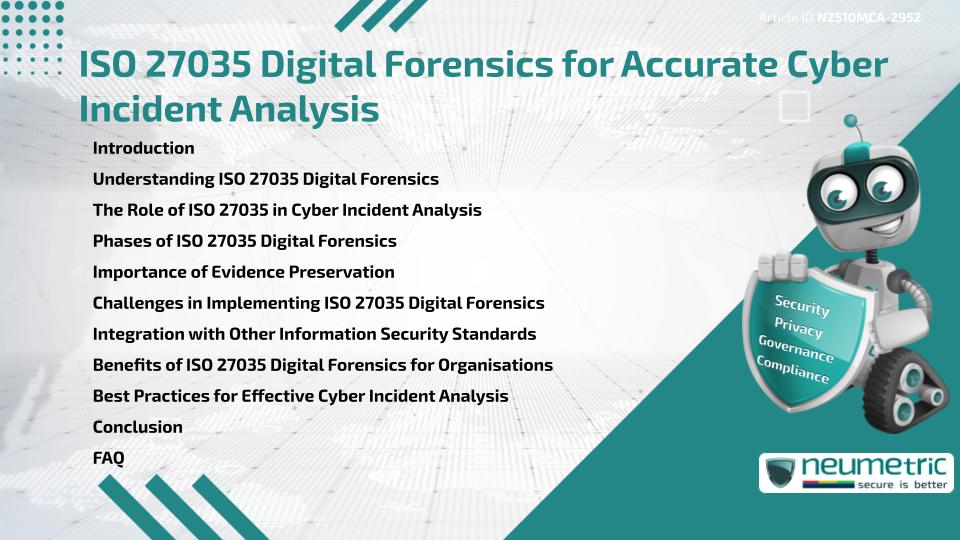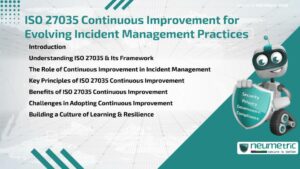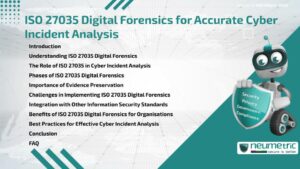Table of Contents
ToggleIntroduction
The rising frequency of cyber incidents demands an organized & Evidence-based approach to investigation. ISO 27035 Digital Forensics provides a globally recognized Framework for managing & analyzing cyber incidents with precision. This Standard ensures that Digital Evidence is properly collected, preserved & interpreted, minimizing errors & maintaining integrity throughout the investigation process. By aligning with this standard, Organisations strengthen their Cybersecurity posture, improve Incident Response accuracy & foster compliance with international Information Security Best Practices.
This article explores the foundations, phases, benefits & challenges of ISO 27035 Digital Forensics, along with its integration into wider security management systems.
Understanding ISO 27035 Digital Forensics
ISO 27035 Digital Forensics is part of the ISO/IEC 27000 family of Standards focused on Information Security Management. It provides a structured approach to handling Security Incidents by emphasizing readiness, detection, analysis, response & lessons learned. Unlike general Forensic processes, ISO 27035 places Digital Forensics at the core of incident management, ensuring every Digital footprint is preserved & analyzed scientifically.
According to the International organisation for Standardization, ISO 27035 ensures that the process of incident handling follows internationally accepted practices. This alignment enhances transparency, accountability & the reliability of Evidence used in legal or regulatory investigations.
The Role of ISO 27035 in Cyber Incident Analysis
The central role of ISO 27035 Digital Forensics is to guide Organisations through systematic incident analysis. It bridges the gap between technical investigation & strategic decision-making. Through predefined steps & documentation requirements, it helps ensure that cyber incidents are managed with both speed & accuracy.
Moreover, ISO 27035 supports cross-functional collaboration between IT, legal & compliance teams. This collaboration ensures that incidents are not only resolved but also properly documented for Audit trails & Continuous Improvement. Following ISO 27035 guidelines ensures that Digital artifacts, such as system logs or communication traces, are collected with proper chain-of-custody documentation.
Phases of ISO 27035 Digital Forensics
The ISO 27035 Digital Forensics Framework operates in three primary phases:
- Preparation & Readiness: Organisations establish Policies, tools & trained personnel ready to respond to potential incidents.
- Detection & Analysis: Incident identification, triage & root-cause analysis occur using Digital Forensic methods.
- Response & Lessons Learned: Actions are taken to contain, eradicate & recover from incidents while integrating lessons into future readiness.
Each phase builds on the previous, ensuring Continuous Improvement in the organisation’s Forensic & response capabilities. For a detailed overview, refer to NIST’s Computer Security Incident Handling Guide.
Importance of Evidence Preservation
A critical component of ISO 27035 Digital Forensics is maintaining the integrity of Evidence. Digital Evidence can easily be altered or lost if not handled properly. The Standard mandates chain-of-custody procedures to track who accessed what data, when & why.
Effective Evidence preservation not only supports technical remediation but also ensures that findings can withstand legal scrutiny. This is particularly crucial in cases involving insider Threats or data breaches with regulatory implications, where mishandling Evidence could invalidate an entire investigation.
Challenges in Implementing ISO 27035 Digital Forensics
While the benefits are clear, Organisations often face challenges in implementing ISO 27035 Digital Forensics. Common obstacles include:
- Lack of trained Forensic professionals
- Insufficient investment in specialized tools
- Difficulty integrating the Standard with existing processes
These challenges can be mitigated through staff training, adopting automated Forensic tools & maintaining an updated Incident Response Plan.
Integration with Other Information Security Standards
ISO 27035 Digital Forensics is not an isolated Framework. It integrates seamlessly with other Information Security Standards such as ISO 27001 (Information Security Management System [ISMS]) and ISO 27037 (Guidelines for Evidence Collection). This integration ensures that Forensic readiness aligns with overall information Governance & Risk Management.
By embedding ISO 27035 practices within an ISMS, Organisations can achieve both compliance & resilience against emerging Cyber Threats.
Benefits of ISO 27035 Digital Forensics for Organisations
Organisations that adopt ISO 27035 Digital Forensics enjoy numerous advantages:
- Improved accuracy in incident analysis
- Faster response times & reduced damage
- Legal defensibility through documented Evidence handling
- Enhanced trust among Stakeholders & regulators
- Continuous Improvement in security posture
By applying these principles, companies demonstrate commitment to transparency & operational resilience.
Best Practices for Effective Cyber Incident Analysis
To get the most from ISO 27035 Digital Forensics, Organisations should:
- Maintain a clear Incident Response Plan
- Conduct periodic Forensic readiness assessments
- Train personnel in Digital Evidence handling
- Integrate Forensic tools with monitoring systems
- Regularly review lessons learned & update controls
Following these Best Practices ensures that Organisations remain vigilant, prepared & compliant when facing cyber incidents.
Conclusion
ISO 27035 Digital Forensics transforms cyber incident analysis from a reactive task into a proactive, structured process. By emphasizing Evidence integrity, analytical rigor & procedural compliance, it allows Organisations to manage incidents effectively while safeguarding Digital trust.
Takeaways
- ISO 27035 standardizes cyber incident management through a Forensic lens.
- Evidence integrity is fundamental to accurate incident analysis.
- Integration with ISO 27001 & ISO 27037 enhances organizational security.
- Continuous Training & Forensic readiness assessments are key to compliance.
- Adopting ISO 27035 improves trust, accountability & resilience.
FAQ
What is the purpose of ISO 27035 Digital Forensics?
It provides a structured approach to incident management & Digital Evidence handling to ensure accuracy & integrity.
How does ISO 27035 differ from other Cybersecurity Frameworks?
Unlike general Frameworks, it focuses specifically on incident handling, Evidence collection & Forensic readiness.
Can ISO 27035 be integrated with ISO 27001?
Yes, ISO 27035 complements ISO 27001 by focusing on operational Incident Response within the broader ISMS Framework.
Why is Evidence preservation important?
Proper preservation ensures that Digital data remains authentic, admissible & reliable in legal or regulatory proceedings.
What challenges do Organisations face when implementing ISO 27035?
Common challenges include lack of expertise, tool limitations & difficulties aligning with existing response processes.
Is ISO 27035 applicable to all industries?
Yes, it applies to any organisation that handles Digital information & wants to strengthen its incident management processes.
How can an organisation improve Forensic readiness?
Regular training, predefined response plans & implementing Forensic tools aligned with ISO 27035 enhance readiness.
What are the key phases of ISO 27035 Digital Forensics?
The key phases are preparation, detection, analysis, response & learning.
References:
- ISO – ISO/IEC 27035 Overview
- NIST SP 800-61 Rev. 2 – Computer Security Incident Handling Guide
- SANS Institute – White Papers on Incident Response
Need help for Security, Privacy, Governance & VAPT?
Neumetric provides organisations the necessary help to achieve their Cybersecurity, Compliance, Governance, Privacy, Certifications & Pentesting needs.
Organisations & Businesses, specifically those which provide SaaS & AI Solutions in the Fintech, BFSI & other regulated sectors, usually need a Cybersecurity Partner for meeting & maintaining the ongoing Security & Privacy needs & requirements of their Enterprise Clients & Privacy conscious Customers.
SOC 2, ISO 27001, ISO 42001, NIST, HIPAA, HECVAT, EU GDPR are some of the Frameworks that are served by Fusion – a SaaS, multimodular, multitenant, centralised, automated, Cybersecurity & Compliance Management system.
Neumetric also provides Expert Services for technical security which covers VAPT for Web Applications, APIs, iOS & Android Mobile Apps, Security Testing for AWS & other Cloud Environments & Cloud Infrastructure & other similar scopes.
Reach out to us by Email or filling out the Contact Form…





